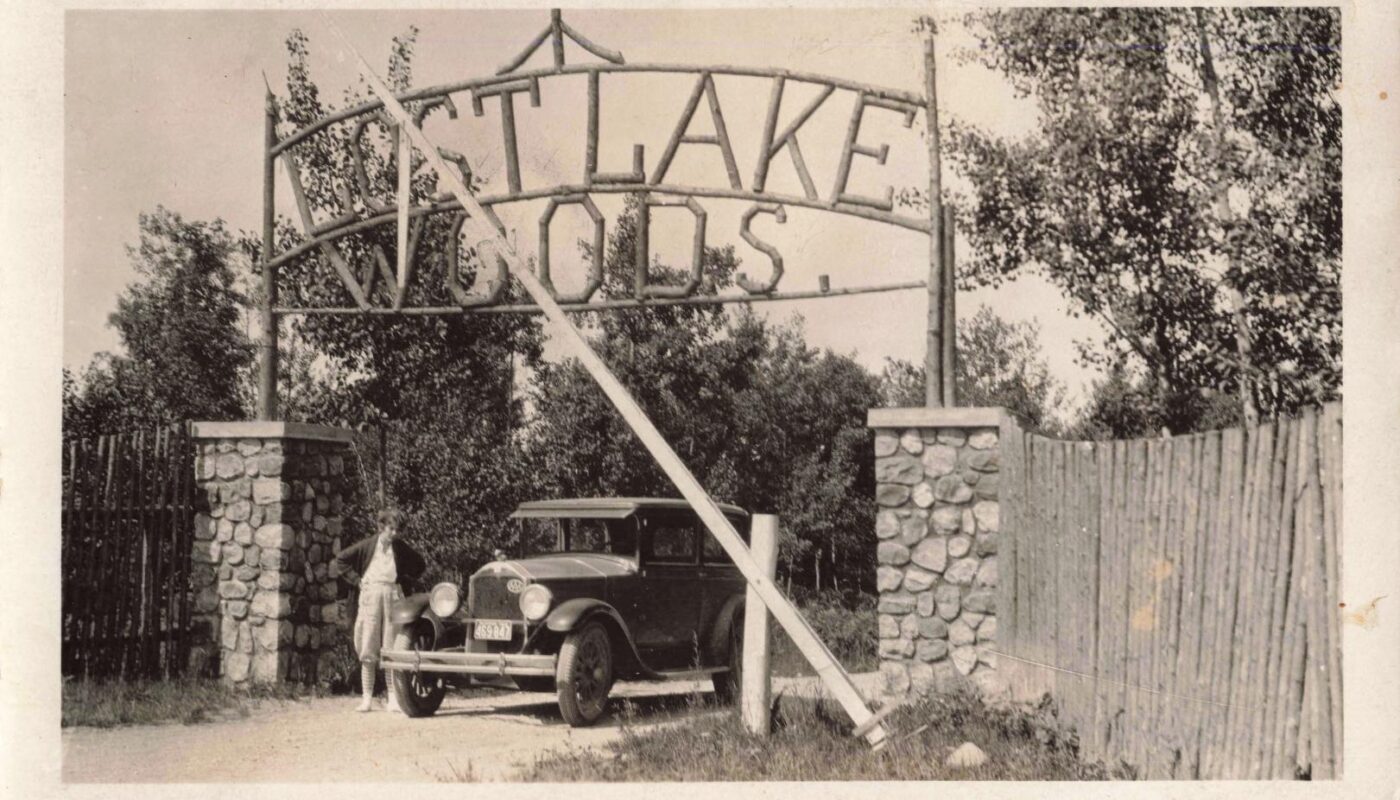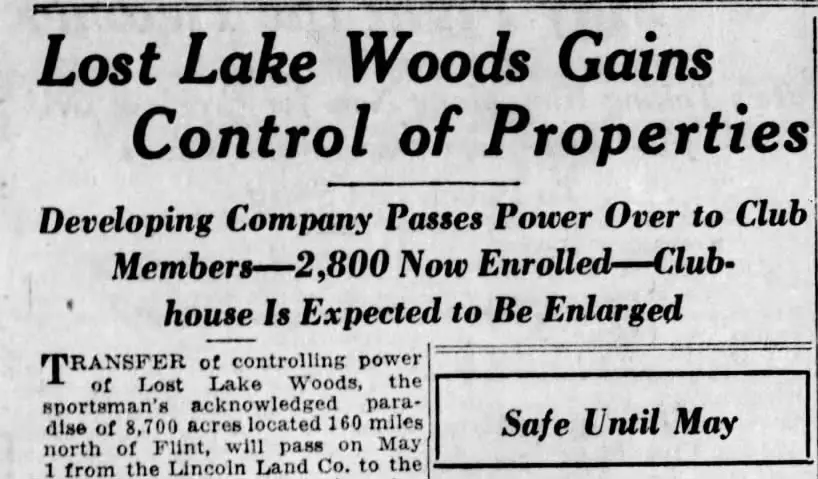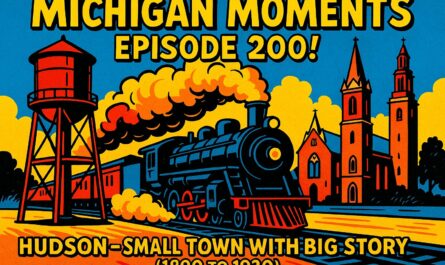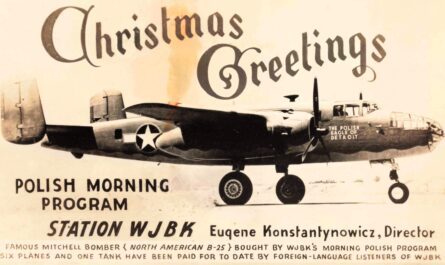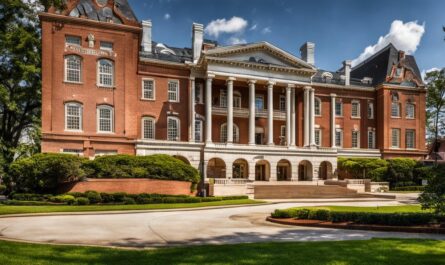Located near Lincoln in Alcona County, Michigan, the Lost Lake Woods Club has a rich history rooted in the early 20th-century conservation and recreation movement. Founded in the 1920s, this private member-owned resort community evolved from logged timberland into a family-oriented haven for hunting, fishing, golf, and outdoor traditions. The period from 1900 through 1950 saw the club’s birth, growth, challenges, and the establishment of many traditions that define its character. Below, we explore the club’s founding, key personalities, major events, recreational activities, and any notable disputes or environmental initiatives during its first half-century.
Table of Contents
Video – Lost Lake Woods Club History How Fire, Hunting, and Family Built a Michigan Tradition
Origins in the North Woods: From Logging to Leisure
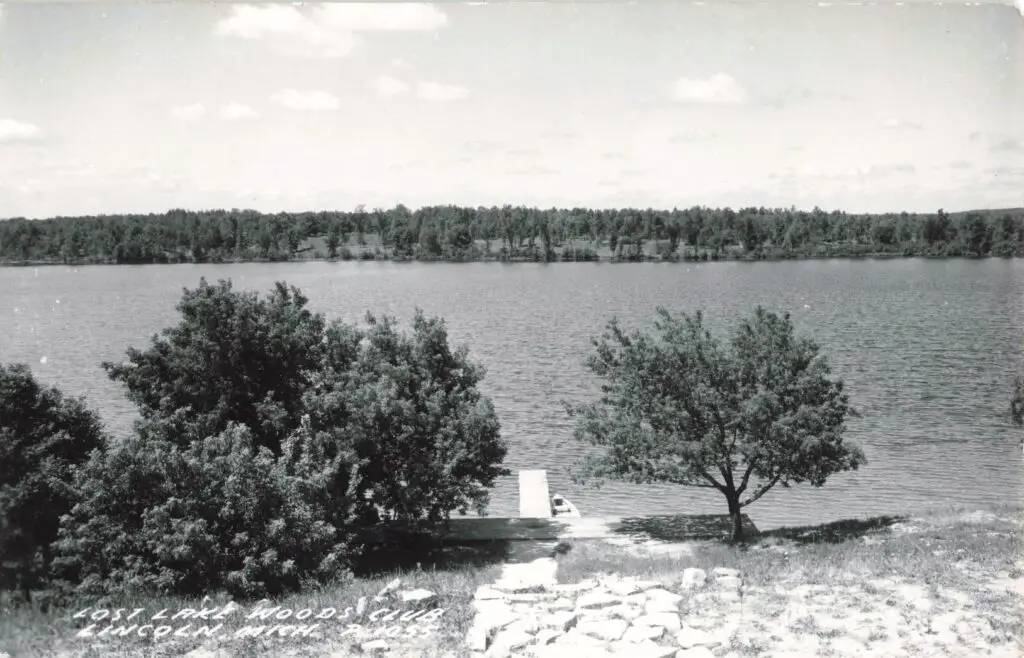
In the late 19th and early 20th centuries, the area that would become Lost Lake Woods was dominated by logging. Alcona County’s vast pine and hardwood forests were heavily harvested, and by the 1920s much of the timber was gone. As the lumber era waned, enterprising developers saw new potential in the cutover land. The A. J. Monteith Land Company of Pontiac, Michigan acquired and assembled thousands of acres north of the village of Lincoln, aiming to repurpose the land for recreation. This transition from timber to tourism was part of a broader trend in northern Michigan, as clear-cut lands were rebranded for hunting clubs, resorts, and second homes.
Founding of Lost Lake Woods Club (1926)
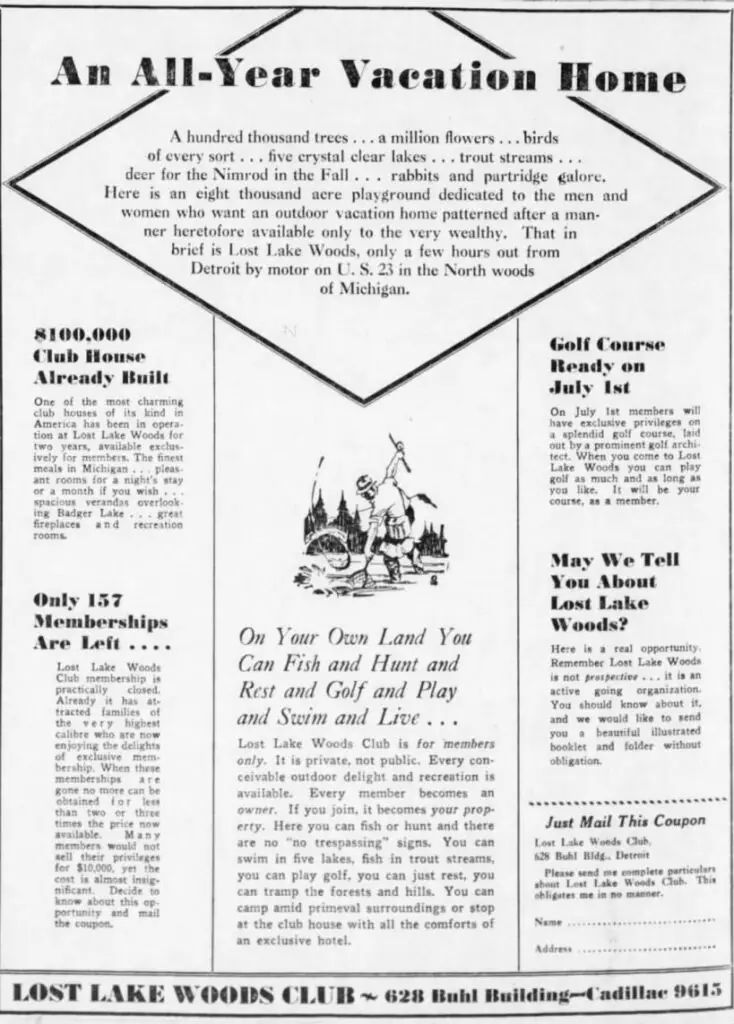
In 1926, the Monteith interests – operating locally as the Lincoln Land Company – officially founded the Lost Lake Woods Club. The founding vision was to create an inclusive outdoor club with a family-oriented atmosphere where everyone was welcomed. In fact, contemporary accounts refer to it as a “workingman’s outdoor club,” highlighting that it was meant not just for society’s elite but for ordinary families who loved the outdoors. The club was established as a private, member-owned conservation club from the outset, reflecting ideals of wildlife preservation and family recreation.
Early on, the developers laid down requirements to ensure the club’s appeal. The original property deeds stipulated that a suitable clubhouse be built on the shore of Badger Lake for the benefit of all lot owners, with a deadline of 1927 for its completion. True to plan, the first lodge (clubhouse) opened in 1927, providing lodging, dining, and social space for members and guests. The club also plotted home sites around the property, anticipating a community of members with private cabins or cottages. By the late 1920s, Lost Lake Woods Club controlled roughly 10,000 acres of forestland and lakes, offering ample room for hunting, fishing, and other pursuits.
Early Amenities and Activities
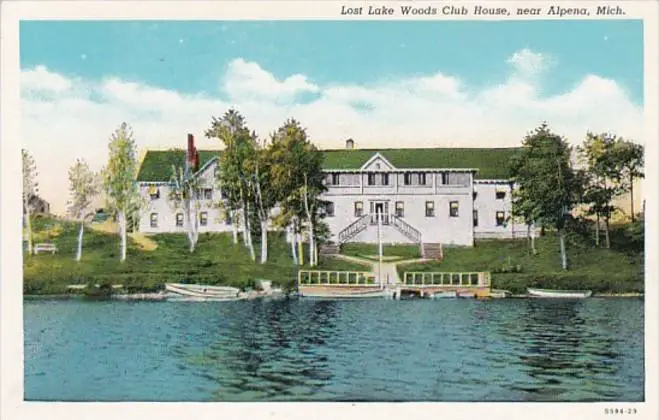
From its beginning, Lost Lake Woods Club was designed as a multi-faceted outdoor retreat. Hunting and fishing were primary draws – the club’s sprawling property encompassed dense woodlands teeming with deer and other game, as well as several lakes (such as Badger Lake and nearby Lost Lake) stocked with fish. Autumn deer hunting season quickly became a cherished tradition; each November, members from downstate would trek north to participate in the annual hunt in Alcona’s wilderness. Black bear hunting was also a notable activity in the club’s early years, as northern Michigan’s woods still had healthy bear populations. Tales of successful bear hunts and hefty buck trophies were commonly shared among members, reinforcing the club’s reputation as a hunter’s paradise.
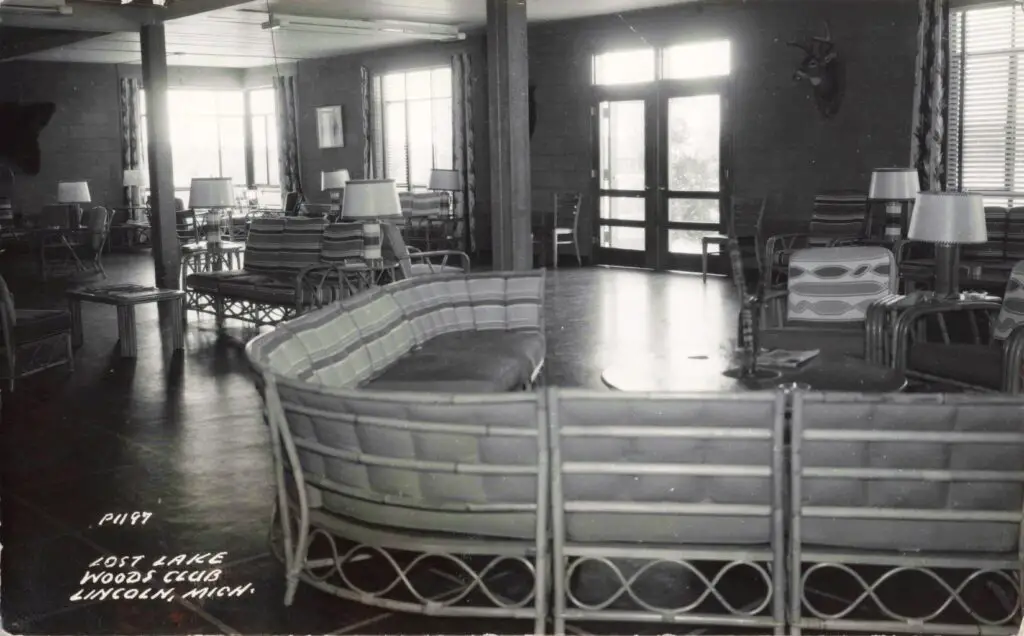
Golf was another key feature introduced early. An initial golf course was built around the time of the club’s founding (year-built 1926, per club records). In its early configuration the course gave members a chance to recreate when not in the woods or on the water. Over time this course would be expanded and improved (it eventually became a private 18-hole golf course on the premises), but even in the 1920s golf was part of the club’s identity. A contemporary brochure boasts of “exemplary golf” alongside hunting and fishing opportunities, showing that from the start Lost Lake Woods aimed to balance sport shooting with genteel leisure.
Other amenities grew in tandem. By the 1930s, the club maintained horse stables and riding trails through the property’s rolling terrain, allowing members to explore on horseback. Five lakes within the club lands were available for boating or swimming in summer. An 84-site campground would later be established, and winter sport facilities (like cross-country ski and snowshoe trails) were also part of the all-seasons approach.
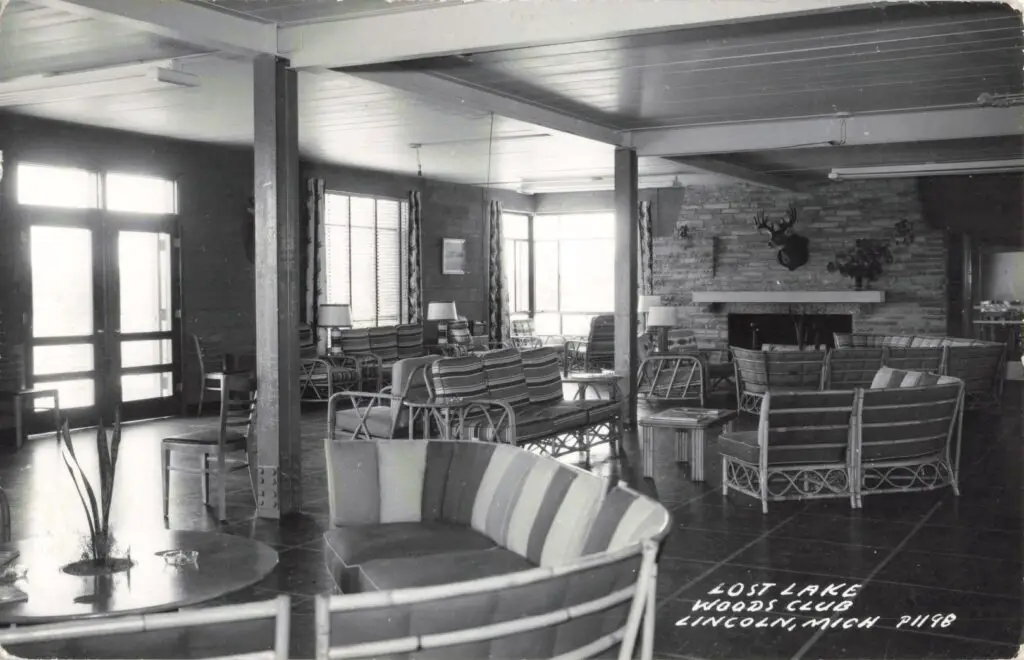
Social gatherings were held at the lodge – from holiday dinners to summertime dances – fostering a close-knit community among the member families. In short, within a few years of its founding, Lost Lake Woods Club offered a well-rounded menu of outdoor recreation: “hunting, fishing and golf” being the headline attractions, with shooting sports, boating, riding, and family socials rounding out the experience.
Key People and Community Leadership

The founding and early development of Lost Lake Woods Club involved a mix of downstate investors and local managers. A. J. Monteith, a Pontiac-based land developer, was a central figure – his company not only acquired the land but guided the club’s initial design and sales effort. Monteith had a broader vision of creating private sporting clubs in northern Michigan (his firm undertook similar projects, like the Canada Creek Ranch in the 1930s), so Lost Lake Woods was one of his early ventures. Under Monteith’s direction, the Lincoln Land Company handled lot sales and club memberships in the late 1920s.
On a day-to-day level, early governance fell to an elected Board of Directors and officers of the Lost Lake Woods Association (the corporate name of the club’s membership). For example, period newspapers from 1930–1931 mention a John Mason attending directors’ meetings in Pontiac on behalf of the club, indicating that members from various Michigan communities were involved in leadership.
The club’s secretary in the 1930s, Roy Brooks, is another notable figure – Brooks coordinated with state conservation officials to improve the club’s natural resources. It was at Mr. Brooks’ request that in 1936 the Michigan Institute for Fisheries Research sent biologists to survey the club’s lakes and streams, an early sign of the club’s commitment to scientific land management. Local staff, such as lodge managers, game wardens, and groundskeepers, also played crucial roles in the club’s operations and culture, though their names were less documented. Together, these founders and stewards established a tradition of member-led management and conservation-minded oversight that would define the club’s character.
The Great Depression and Member Ownership
The economic turbulence of the 1930s brought significant changes to Lost Lake Woods Club. The Great Depression hit soon after the club’s founding, which likely made it difficult for some members to maintain dues or for the developers to sell recreational lots. Despite the hardships, the club survived the early 1930s, in part by tightening its community spirit and emphasizing affordable outdoor recreation – true to its “workingman’s club” roots.
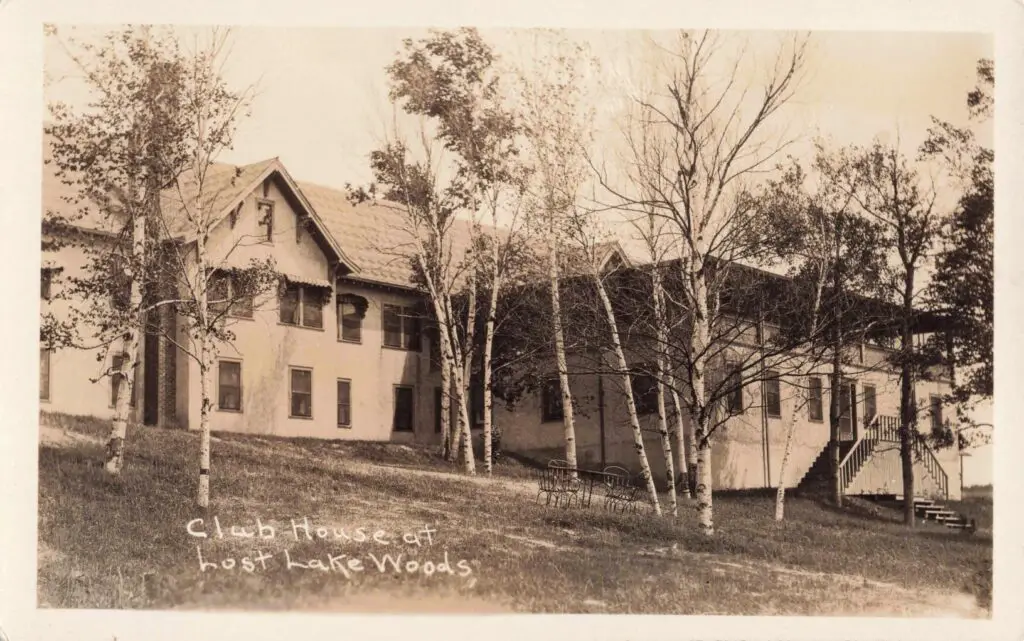
A major turning point came in 1934, when the ownership and governance structure shifted from the founding land company to the members themselves. In that year, the Lincoln Land Company (Monteith’s entity) passed control of the club to the Lost Lake Woods Association – effectively, the club members collectively took over ownership of the land and facilities. This transition meant Lost Lake Woods became fully member-owned and democratically run, with an elected board managing club affairs.

The 1934 handover appears to have been a smooth process (unlike some other clubs where members had to wrest control from developers through legal disputes). In the case of Lost Lake Woods, it was likely a mutually agreed outcome as the original developer had accomplished the initial build-out and sales. The club’s financial model transitioned to member dues and fees supporting operations. This change cemented the idea that “our members are our shareholders” – each family with a membership lot had a stake and a voice in the club’s future. No notable legal controversies accompanied this change; rather, it was seen as a positive development ensuring the club’s longevity during tough economic times.
Through the late 1930s, the member-led club kept improving amenities (within modest means) and maintained its core activities. Records show, for example, that in 1937 the club was investing in habitat and fisheries improvements, working with state experts to enhance game fish populations in its lakes. Such efforts during the Depression era underscore how the members prioritized conservation and the quality of the outdoor experience, even when finances were lean.
Recreational Traditions and Community Life
During the 1926–1950 period, Lost Lake Woods Club cultivated many traditions that bonded its membership. Seasonal events became a rhythm of club life. In spring and summer, families would come north when school was out to enjoy fishing derbies on the lakes, family picnics on the shore, and golf tournaments on the club’s course. The club lodge served as a venue for holiday gatherings – one can imagine Fourth of July barbecues by the lake and festive dinners at Thanksgiving for those who ventured up in late autumn.
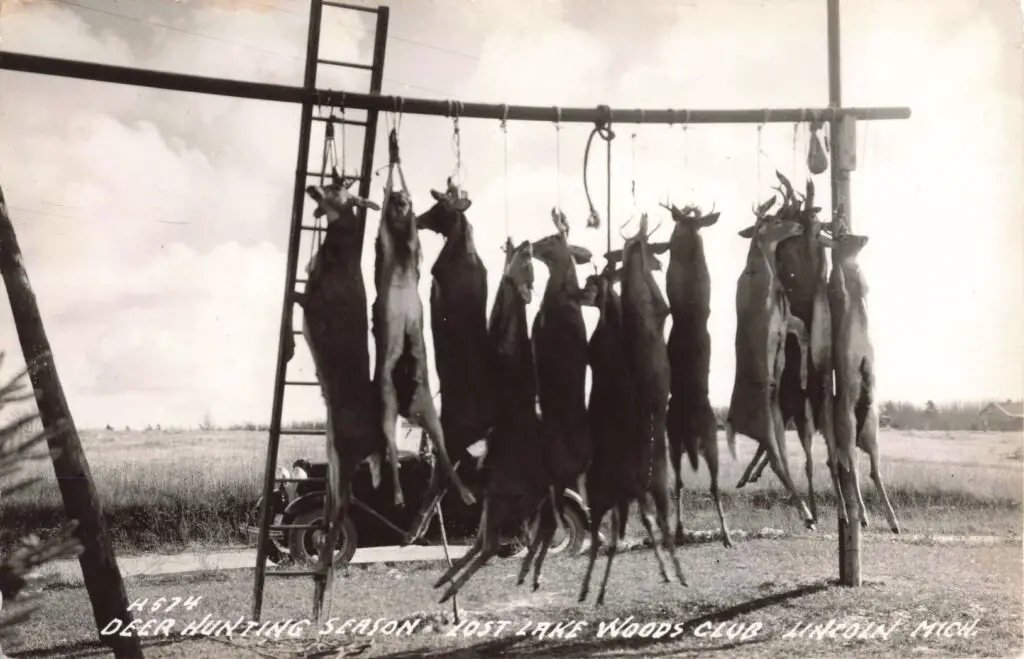
Fall deer hunting season was perhaps the marquee event of the year. Members formed hunting parties and established annual deer camps on club grounds; often the same groups of friends and relatives would reunite each November for the opening day of rifle season. Local newspapers in Michigan regularly noted downstate residents “leaving for Lost Lake Woods Club in Alcona County to join the North’s deer hunt,” illustrating how ingrained this tradition was by the 1930s.
A celebratory camaraderie surrounded the successful harvest of deer and bear – photographs of members with their bucks (and occasionally black bears) were proudly displayed on the lodge bulletin boards. The club likely had a “buck pole” or similar customary display for deer, as was common in Michigan hunting camps.
Throughout the year, shooting sports were popular as well. The club established rifle and shotgun ranges where members could sharpen their aim. Trap and skeet shooting competitions were held, fostering friendly rivalry. Bird hunting (grouse and woodcock in the surrounding woods) was another fall attraction for many members, with guided hunts or informal groups venturing out when in season.
On the golf side, the club organized regular tournaments and league play by the 1940s. Club records indicate there were men’s and women’s golf days each week and an annual club championship – modest in scale, but important in building social connections. Given the family emphasis, children were not left out; the club encouraged youth outdoor activities, from supervised fishing outings to a junior golf program (teaching the next generation the values of honesty and sportsmanship through the game).
Winters were quieter but still offered recreation: members who visited in the snowy months enjoyed ice fishing on the lakes, cross-country skiing on trails, and skating or sledding. A winter weekend at the lodge, warming by the great stone fireplace after a day outdoors, was a treasured experience for the hardy few who braved Michigan’s cold.
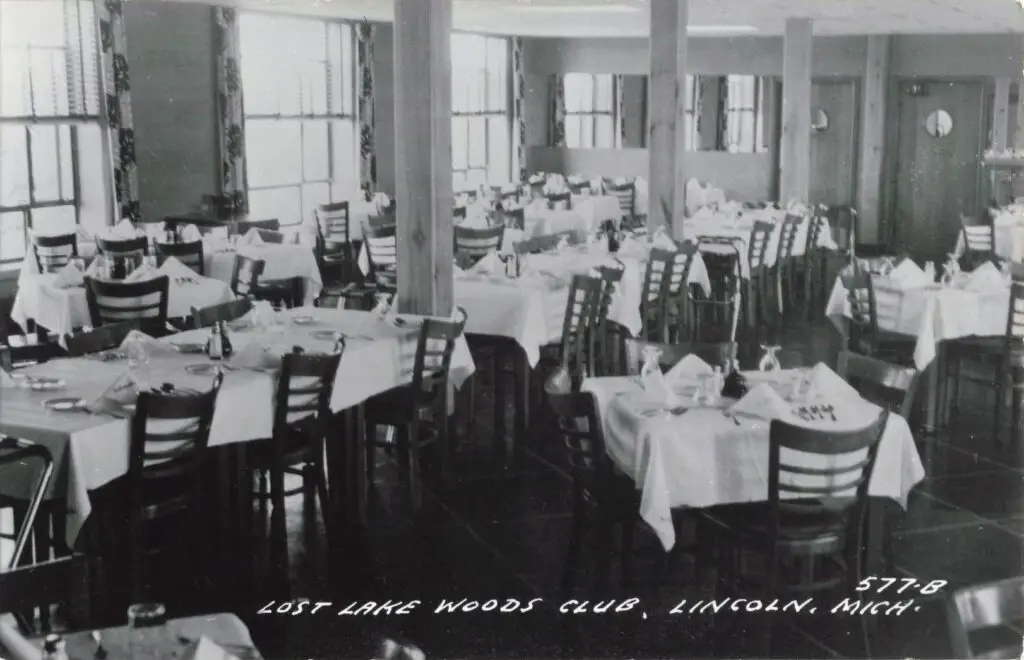
Socially, club-sponsored gatherings rounded out the calendar. These included annual meetings, summer barbecues, ladies’ luncheons, and occasional dances or themed parties held in the clubhouse ballroom. Oral histories suggest that Saturday night dances were held during the summer season in the 1930s, often with a local band playing and members dressing up for an evening of dancing and cards.
The club also observed certain traditions like an end-of-summer children’s talent show or a Labor Day family field day. All these activities and traditions helped reinforce a sense of community. Members often referred to the club as their “home away from home,” a phrase that continues to this day. By 1950, many member families were multi-generational (the original purchasers’ children were now adults), and the traditions they established in these early decades – the annual hunts, the family reunions at the lodge, the friendly competitions – laid the foundation for the club’s enduring culture.
Challenges of World War II and the 1940s
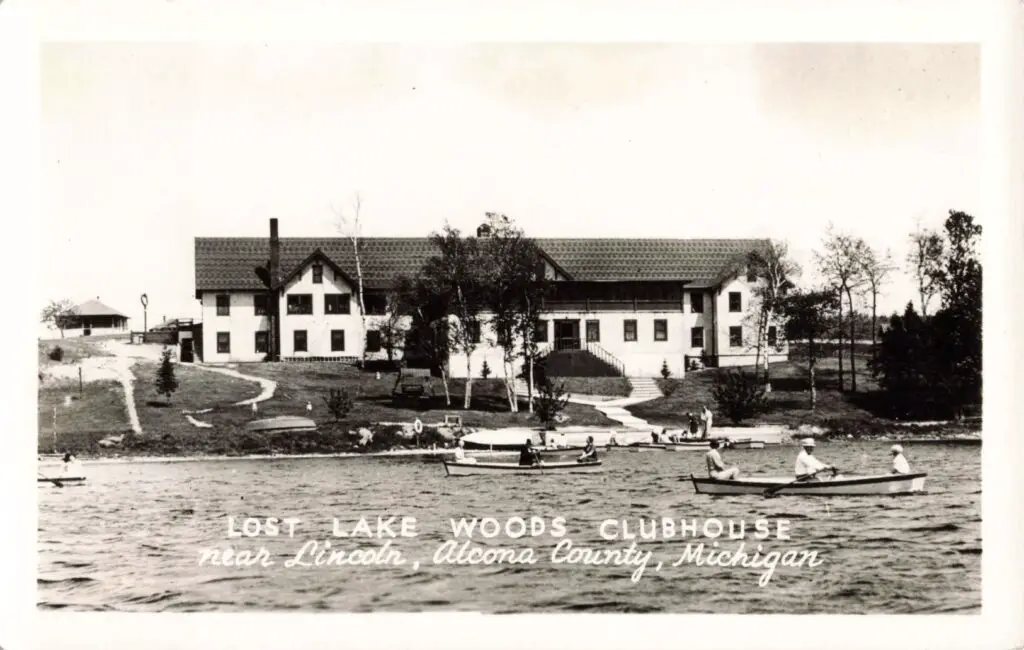
The onset of World War II (1941–1945) brought its own impacts to Lost Lake Woods Club. With many younger members serving in the military and travel restricted by gasoline rationing, the club likely saw lower attendance in those years. Club minutes from the early 1940s (if examined) probably note adjustments like reduced services or postponed events due to wartime constraints.
Still, the club remained open, and older members or families not directly involved in the war effort continued to make use of the property for hunting and relaxation, providing a semblance of normalcy during uncertain times. There was also a sense of patriotic contribution: members are said to have cooperated with wartime game regulations (to conserve deer populations) and perhaps participated in scrap drives or victory gardens even up at their northern cottages. The war era passed without any known direct controversy at the club, but it did require patience and conservation – fitting the club’s ethos.
Fire Distroys Clubhouse 1946

Grand Rapids, Michigan
Thu, Aug 15, 1946 · Page 1
In the mid-1940s, just as peacetime returned, Lost Lake Woods faced one of the most dramatic events in its history: a catastrophic fire. In 1946, a blaze destroyed the original clubhouse lodge that had stood since 1927. The fire swept through the building (accounts vary whether it was late 1945 or early 1946, but club records place the disaster in 1946), reducing the beloved white-frame lodge to charred ruins.
Fortunately, no loss of life was reported, but the club’s central gathering place – with its dining room, guest rooms, and lakeside porches – was gone. Contemporary reports in the community recalled that flames could be seen from far across Badger Lake as the structure burned. For the membership, it was an emotional blow; generations had made memories in that lodge over nearly twenty years.
The cause of the fire was not widely documented in surviving sources. It may have been an accidental chimney or kitchen fire – wooden resort lodges of that era were notoriously susceptible to flames. What is well documented is the resolve of the club to rebuild quickly. Immediately after the ashes cooled, the Board of Directors “determined that a new Club House shall be designed and built that will never again be destroyed by fire”. In other words, they committed to constructing the new lodge with more fire-resistant materials and modern safety features. This decision reflects the resilience and dedication of the members to their club.
Postwar Rebuilding and Developments (1946–1950)

In the late 1940s, the focus was on rebirth. The club enlisted architects and builders to create a new lodge on the same scenic site overlooking the lake. Construction moved swiftly: by 1948, a new two-story concrete-and-stone lodge was completed and opened for use. This structure – featuring 52 guest rooms, a grand dining hall, and updated amenities – was a considerable upgrade, yet it was designed to retain the welcoming, homey atmosphere of its predecessor.

True to the board’s mandate, it had a more solid, fireproof construction (including a brick facade and later a pitched roof addition) to avoid the fate of the old wooden lodge. The culmination of this effort was a dedication ceremony on July 3, 1949, when members and local dignitaries gathered to officially christen the new Lost Lake Woods Clubhouse. This event was both a celebration of the rebuilt lodge and a symbolic postwar reunion of the club’s community – many of whom had been dispersed or less active during the war years and were now eager to reconnect.
By 1950, Lost Lake Woods Club had firmly reestablished itself. In fact, the late 1940s were something of a boom time: membership was growing again (hundreds of families were on the roster), and the club’s amenities were the most modern they had ever been. The new lodge became the hub for expanded dining services, larger banquets, and year-round use (with improved heating for winter). The golf course was well-maintained and reportedly in the best shape yet (though it would still be decades before a full professional redesign).
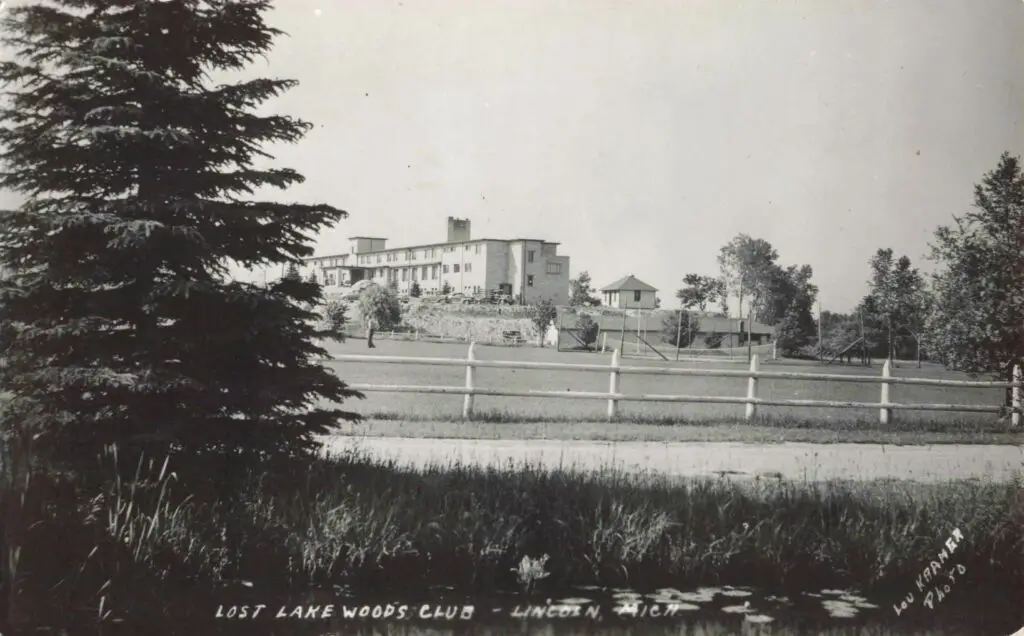
The community of private cottages within the club’s confines had also grown – by 1950 around 100 homes dotted the property (a number that would swell to 500 in later years). The club lands themselves even expanded slightly after the war, with the association acquiring additional acreage, bringing the total controlled land to over 11,000 acres of contiguous wilderness. This ensured a buffer of privacy and plentiful habitat for wildlife.
One notable development just after 1950 (though conceived in the late ’40s) was the creation of Lake Catherine in 1956 – a private lake on club property formed by damming a creek. While outside our main timeframe, it’s worth noting as it was part of the club’s postwar improvements aimed at enhancing fishing opportunities for members. Such projects underscore how the club continually balanced development with outdoor recreation value.
Conservation Ethos and Community Impact
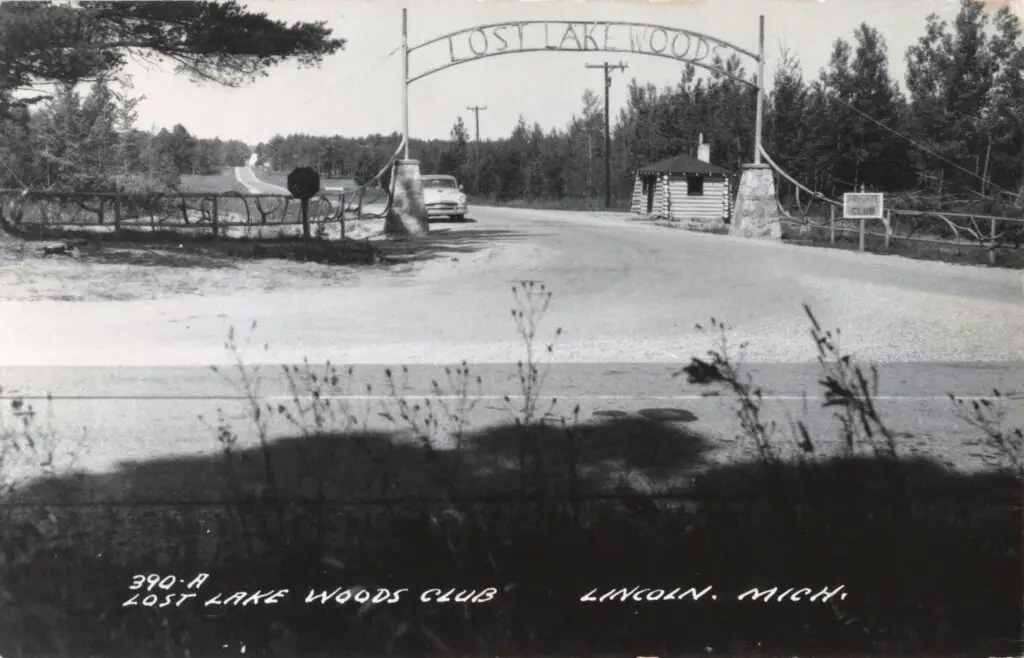
Throughout its early history, Lost Lake Woods Club exemplified a strong conservation ethic rather than generating environmental controversies. There were no significant environmental disputes recorded between 1900 and 1950 involving the club – in fact, the opposite is true: the club often cooperated with state conservation agencies to improve the environment on its property.
A clear example is the 1936–37 fisheries survey mentioned earlier, where club leadership invited biologists to study the lakes and recommend fish management practices. Following those recommendations, the club undertook systematic fish stocking and habitat improvements to ensure sustainable angling for members. Likewise, the large tract of land under club ownership functioned as an informal wildlife sanctuary (hunting was controlled and limited to members, preventing overharvest by the general public).
This private stewardship likely benefited local populations of deer, grouse, and other species. In later years, the club would join Michigan’s formal deer management programs, but even in the 1930s-40s, members were practicing forms of game conservation, such as adhering to state hunting limits and protecting habitat. No pollution or land-use disputes appear in the historical record; the club’s impact on the local environment was generally positive, turning formerly denuded logging land back into thriving forest and wetland habitat.
Local Relationships With The Club
In terms of legal disputes or controversies in this early period, there are few notable incidents. The club’s transformation to member ownership in 1934 proceeded amicably without lawsuits. The club maintained a low public profile, being a gated community “strictly for members and guests only”, which meant there was little opportunity for conflicts with non-members.
One could argue that the exclusivity itself (controlling such a large swath of land for private use) was occasionally a point of local resentment, but if so, it was minor and not documented in the press. On the contrary, the club was a boon to the local economy of Alcona County: it provided employment (staff for the lodge, maintenance, etc.), and members patronized businesses in Lincoln and nearby towns. From time to time, local officials and residents were invited to club events, fostering goodwill. In short, the first decades of Lost Lake Woods Club were marked more by cooperation and community-building than by controversy.
Legacy of the Early Years

By 1950, Lost Lake Woods Club had established itself as one of Michigan’s premier private outdoor clubs – “one of the oldest and finest private member-owned clubs in Michigan,” as a later manager would describe it. Its early history is a story of foresight and resilience: founded on the heels of the logging era, grown through the Great Depression, tempered by war, and renewed after a devastating fire.
Key individuals like A. J. Monteith provided the initial spark, while the member families carried the torch forward, creating a lasting institution. The club’s traditions of bear and deer hunting, fishing adventures, golf tournaments, and family gatherings all took root in those first 25 years and continued for generations. Equally important, the ethos of conservation, camaraderie, and community self-governance was firmly ingrained.
As the club moved into the second half of the 20th century, it would continue to expand and modernize – but the foundation laid from 1900 to 1950 ensured that Lost Lake Woods would always cherish its past. The lodge and lakes might have new visitors, and the mode of travel might shift from Model A’s to modern SUVs, yet the spirit remains as it was in the beginning: a place where families and friends come to enjoy “the finer things in life” in an unspoiled natural setting, forging memories in Michigan’s north woods that last a lifetime.
Sources:
- Alcona Historical Society, Driving Tour A: Historic Sites, entry on Lost Lake Woods Club (1926 founding as “Workingman’s Club,” member takeover in 1934, clubhouse fire in 1945)
- Lost Lake Woods Club official documents and website (founding year 1926 and family-oriented conservation mission; facility descriptions and amenities)
- Michigan Railroads Association history note on Lost Lake Woods (development by A. J. Monteith Land Co. after logging in late 1920s)
- Michigan DNR Fisheries Survey Report No. 406 (Feb 1937) – details of lakes on club property and cooperative fish management efforts with club secretary Roy Brooks.
- Lost Lake Woods Club Ballot Info (Historical Notes) – internal publication (original lodge opened 1927, destroyed by fire in 1946, new fireproof lodge built 1948 and dedicated 1949).
- Lost Lake Woods Club “Golf Course” page (club described as established 1926, “family oriented conservation club”, with hunting, fishing, golf on 10,000+ acres).
- Wikipedia entry for Lost Lake Woods, Michigan (verifies location, private community status, and acreage)
